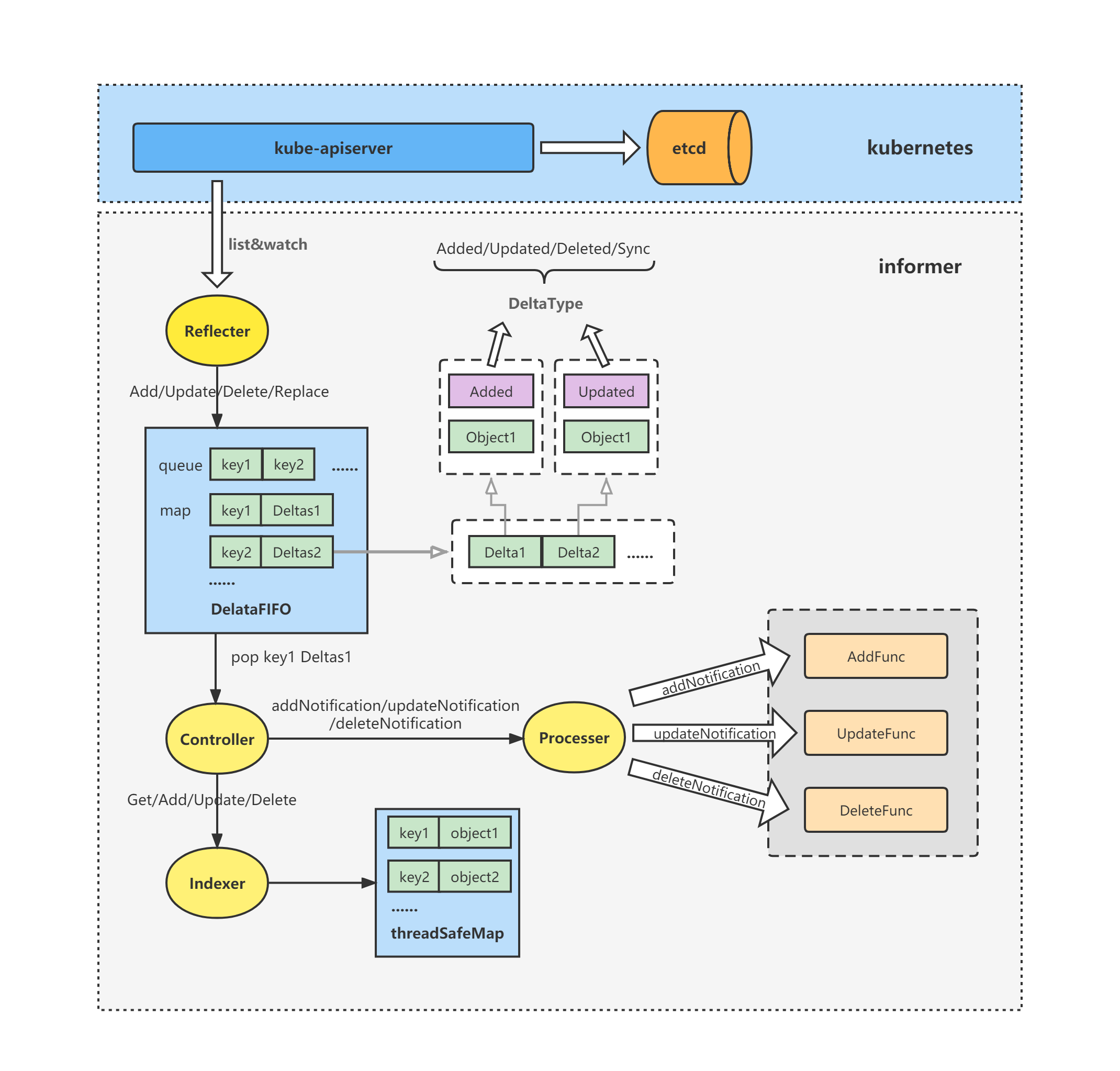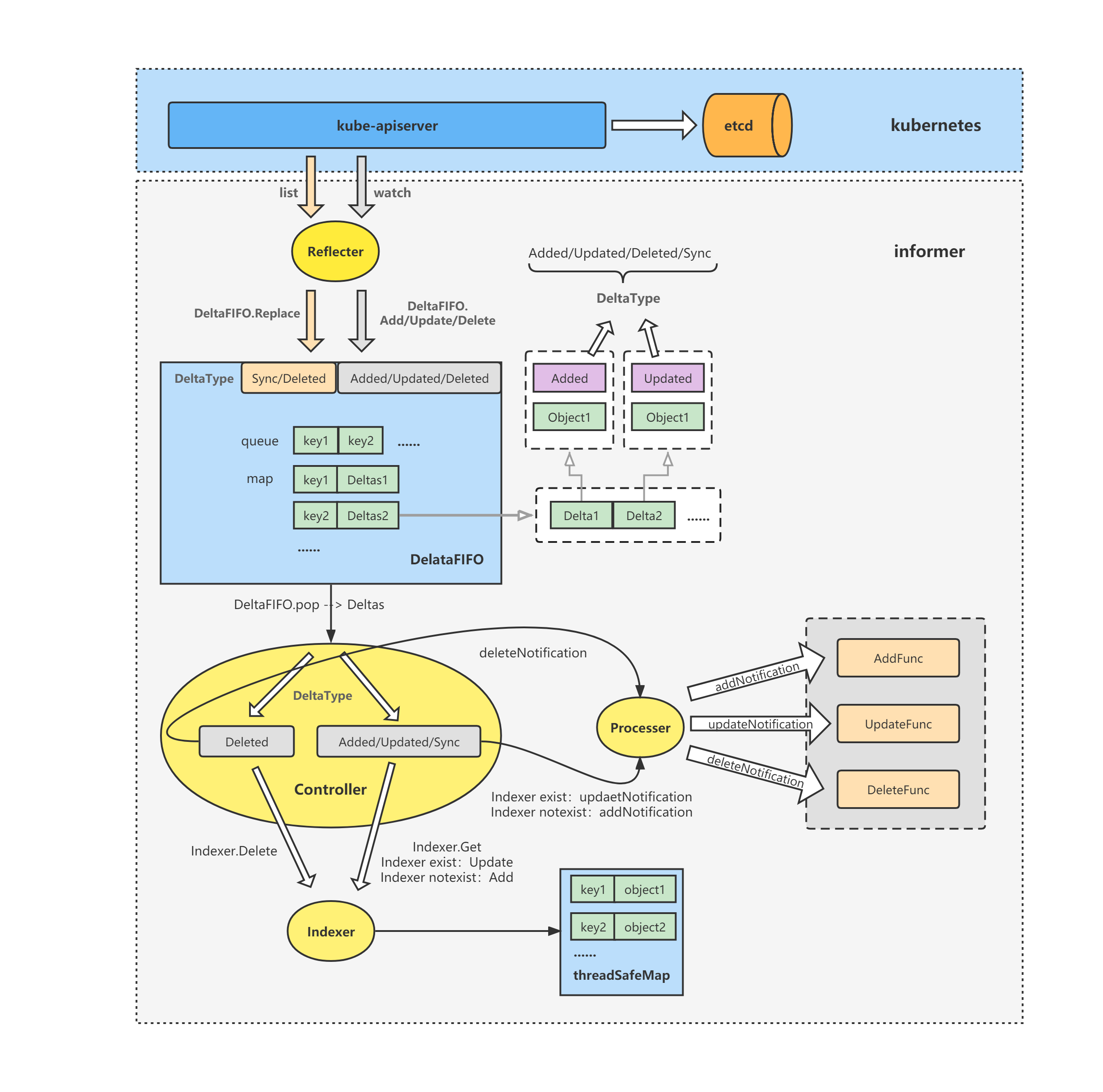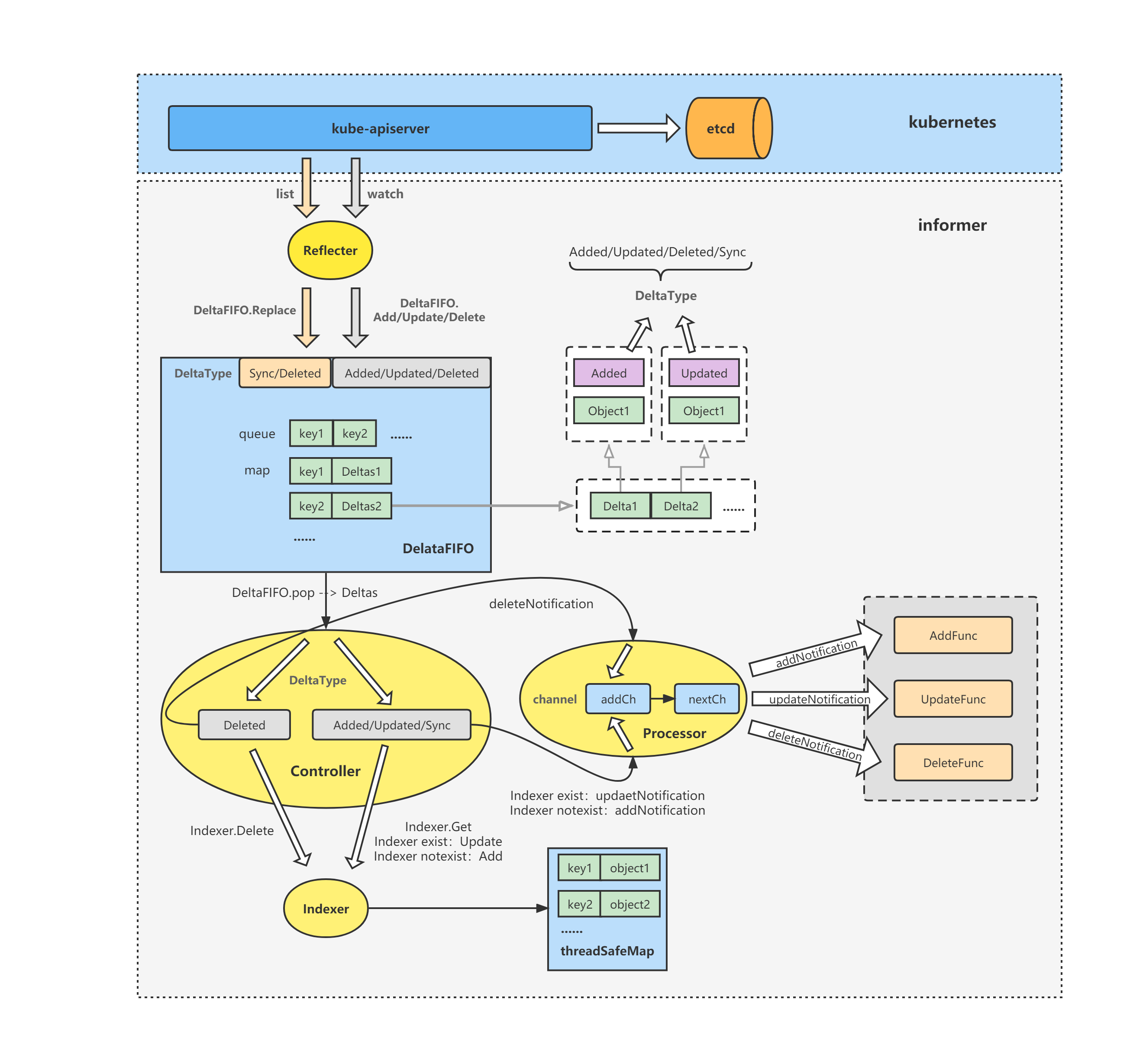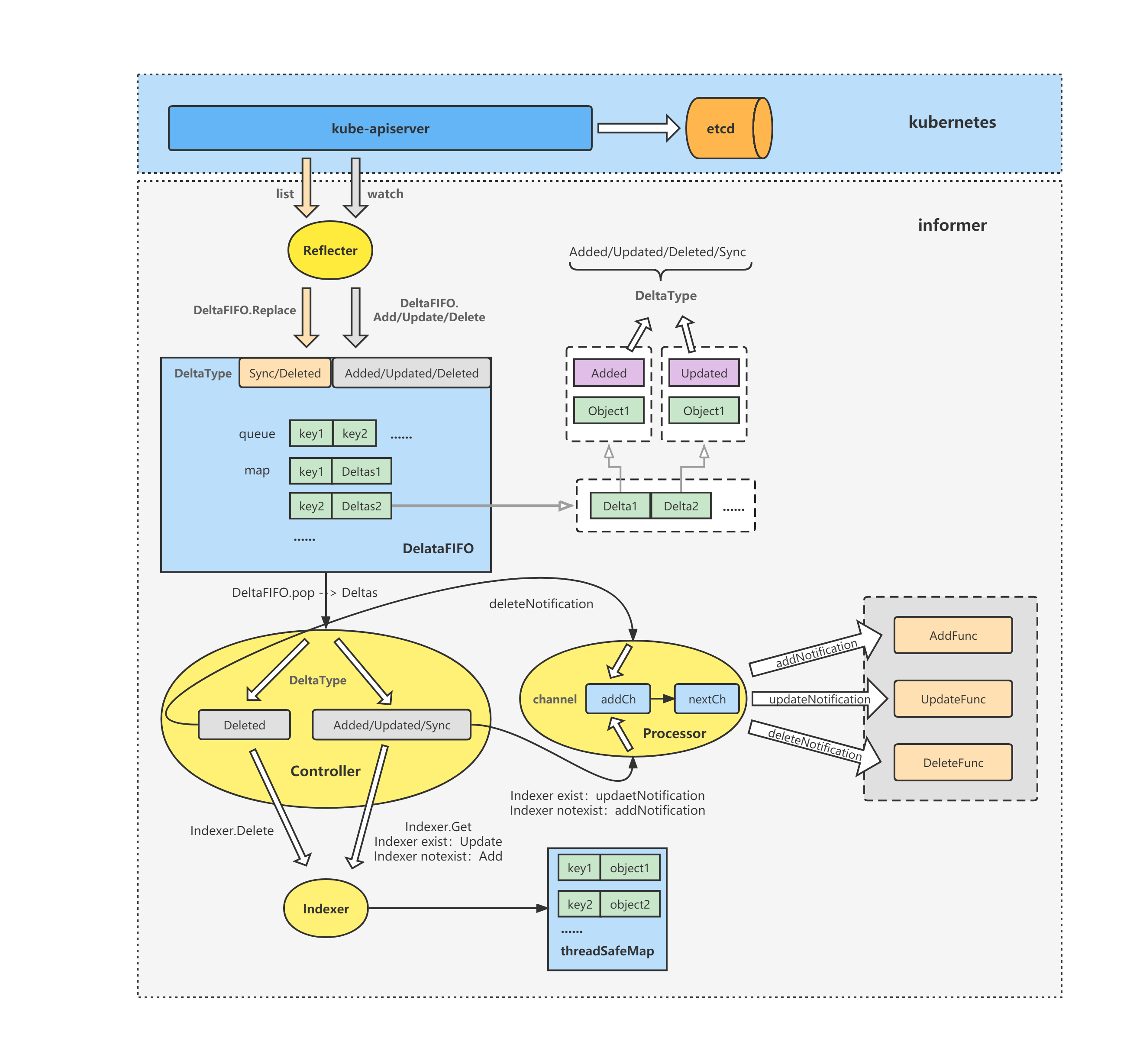k8s client-go源码分析 informer源码分析(5)-Controller&Processor源码分析
client-go之Controller&Processor源码分析
1.controller与Processor概述
Controller
Controller从DeltaFIFO中pop Deltas出来处理,根据对象的变化更新Indexer本地缓存,并通知Processor相关对象有变化事件发生。
Processor
Processor根据Controller的通知,即根据对象的变化事件类型,调用相应的ResourceEventHandler来处理对象的变化。
先通过一张informer概要架构图看一下Controller&Processor所处位置与概要功能。

2.Controller初始化与启动分析
2.1 Cotroller初始化-New
New用于初始化Controller,方法比较简单。
// staging/src/k8s.io/client-go/tools/cache/controller.go
func New(c *Config) Controller {
ctlr := &controller{
config: *c,
clock: &clock.RealClock{},
}
return ctlr
}
2.2 Controller启动-controller.Run
controller.Run为controller的启动方法,这里主要看到几个点:
(1)调用NewReflector,初始化Reflector;
(2)调用r.Run,实际上是调用了Reflector的启动方法来启动Reflector(Reflector相关的分析前面的博客已经分析过了,这里不再重复);
(3)调用c.processLoop,开始controller的核心处理;
// staging/src/k8s.io/client-go/tools/cache/controller.go
func (c *controller) Run(stopCh <-chan struct{}) {
defer utilruntime.HandleCrash()
go func() {
<-stopCh
c.config.Queue.Close()
}()
r := NewReflector(
c.config.ListerWatcher,
c.config.ObjectType,
c.config.Queue,
c.config.FullResyncPeriod,
)
r.ShouldResync = c.config.ShouldResync
r.clock = c.clock
c.reflectorMutex.Lock()
c.reflector = r
c.reflectorMutex.Unlock()
var wg wait.Group
defer wg.Wait()
wg.StartWithChannel(stopCh, r.Run)
wait.Until(c.processLoop, time.Second, stopCh)
}
3.controller核心处理方法分析
controller.processLoop即为controller的核心处理方法。
controller.processLoop
controller的核心处理方法processLoop中,最重要的逻辑是循环调用c.config.Queue.Pop将DeltaFIFO中的队头元素给pop出来(实际上pop出来的是Deltas,是Delta的切片类型),然后调用c.config.Process方法来做处理,当处理出错时,再调用c.config.Queue.AddIfNotPresent将对象重新加入到DeltaFIFO中去。
func (c *controller) processLoop() {
for {
obj, err := c.config.Queue.Pop(PopProcessFunc(c.config.Process))
if err != nil {
if err == ErrFIFOClosed {
return
}
if c.config.RetryOnError {
// This is the safe way to re-enqueue.
c.config.Queue.AddIfNotPresent(obj)
}
}
}
}
根据前面sharedIndexInformer的初始化与启动分析(sharedIndexInformer.Run)可以得知,c.config.Process即为s.HandleDeltas方法,所以接下来看到s.HandleDeltas方法的分析。
c.config.Process/s.HandleDeltas
根据前面分析知道HandleDeltas要处理的是Deltas,是Delta的切片类型。
再来看到HandleDeltas方法的主要逻辑:
(1)循环遍历Deltas,拿到单个Delta;
(2)判断Delta的类型;
(3)如果是Added、Updated、Sync类型,则从indexer中获取该对象,存在则调用s.indexer.Update来更新indexer中的该对象,随后构造updateNotification struct,并调用s.processor.distribute方法;如果indexer中不存在该对象,则调用s.indexer.Add来往indexer中添加该对象,随后构造addNotification struct,并调用s.processor.distribute方法;
(4)如果是Deleted类型,则调用s.indexer.Delete来将indexer中的该对象删除,随后构造deleteNotification struct,并调用s.processor.distribute方法;
// staging/src/k8s.io/client-go/tools/cache/shared_informer.go
func (s *sharedIndexInformer) HandleDeltas(obj interface{}) error {
s.blockDeltas.Lock()
defer s.blockDeltas.Unlock()
// from oldest to newest
for _, d := range obj.(Deltas) {
switch d.Type {
case Sync, Added, Updated:
isSync := d.Type == Sync
s.cacheMutationDetector.AddObject(d.Object)
if old, exists, err := s.indexer.Get(d.Object); err == nil && exists {
if err := s.indexer.Update(d.Object); err != nil {
return err
}
s.processor.distribute(updateNotification{oldObj: old, newObj: d.Object}, isSync)
} else {
if err := s.indexer.Add(d.Object); err != nil {
return err
}
s.processor.distribute(addNotification{newObj: d.Object}, isSync)
}
case Deleted:
if err := s.indexer.Delete(d.Object); err != nil {
return err
}
s.processor.distribute(deleteNotification{oldObj: d.Object}, false)
}
}
return nil
}
type updateNotification struct {
oldObj interface{}
newObj interface{}
}
type addNotification struct {
newObj interface{}
}
type deleteNotification struct {
oldObj interface{}
}
至此,Controller的分析就结束了,用一张图来回忆一下Controller的功能与架构。

4.processor核心处理方法分析
sharedIndexInformer.processor.distribute
接下来分析一下前面提到的s.processor.distribute方法。
可以看到distribute方法最终是将构造好的addNotification、updateNotification、deleteNotification对象写入到p.addCh中。
sync类型的对象写入到p.syncingListeners中,但informer中貌似没有启动p.syncingListeners或对p.syncingListeners做处理,所以sync类型的对象变化(也即list操作得到的对象所生成的对象变化)会被忽略?有待验证。
// staging/src/k8s.io/client-go/tools/cache/shared_informer.go
func (p *sharedProcessor) distribute(obj interface{}, sync bool) {
p.listenersLock.RLock()
defer p.listenersLock.RUnlock()
if sync {
for _, listener := range p.syncingListeners {
listener.add(obj)
}
} else {
for _, listener := range p.listeners {
listener.add(obj)
}
}
}
func (p *processorListener) add(notification interface{}) {
p.addCh <- notification
}
sharedIndexInformer.processor.run
s.processor.run启动了processor,其中注意到listener.run与listener.pop两个核心方法。
这里可以看到processor的run方法中只启动了p.listeners,没有启动p.syncingListeners。
// staging/src/k8s.io/client-go/tools/cache/shared_informer.go
func (p *sharedProcessor) run(stopCh <-chan struct{}) {
func() {
p.listenersLock.RLock()
defer p.listenersLock.RUnlock()
for _, listener := range p.listeners {
p.wg.Start(listener.run)
p.wg.Start(listener.pop)
}
p.listenersStarted = true
}()
<-stopCh
p.listenersLock.RLock()
defer p.listenersLock.RUnlock()
for _, listener := range p.listeners {
close(listener.addCh) // Tell .pop() to stop. .pop() will tell .run() to stop
}
p.wg.Wait() // Wait for all .pop() and .run() to stop
}
processorListener.pop
分析processorListener的pop方法可以得知,其逻辑实际上就是将p.addCh中的对象给拿出来,然后丢进了p.nextCh中。那么谁来处理p.nextCh呢?继续往下看。
// staging/src/k8s.io/client-go/tools/cache/shared_informer.go
func (p *processorListener) pop() {
defer utilruntime.HandleCrash()
defer close(p.nextCh) // Tell .run() to stop
var nextCh chan<- interface{}
var notification interface{}
for {
select {
case nextCh <- notification:
// Notification dispatched
var ok bool
notification, ok = p.pendingNotifications.ReadOne()
if !ok { // Nothing to pop
nextCh = nil // Disable this select case
}
case notificationToAdd, ok := <-p.addCh:
if !ok {
return
}
if notification == nil { // No notification to pop (and pendingNotifications is empty)
// Optimize the case - skip adding to pendingNotifications
notification = notificationToAdd
nextCh = p.nextCh
} else { // There is already a notification waiting to be dispatched
p.pendingNotifications.WriteOne(notificationToAdd)
}
}
}
}
processorListener.run
在processorListener的run方法中,将循环读取p.nextCh,判断对象类型,是updateNotification则调用p.handler.OnUpdate方法,是addNotification则调用p.handler.OnAdd方法,是deleteNotification则调用p.handler.OnDelete方法做处理。
// staging/src/k8s.io/client-go/tools/cache/shared_informer.go
func (p *processorListener) run() {
// this call blocks until the channel is closed. When a panic happens during the notification
// we will catch it, **the offending item will be skipped!**, and after a short delay (one second)
// the next notification will be attempted. This is usually better than the alternative of never
// delivering again.
stopCh := make(chan struct{})
wait.Until(func() {
// this gives us a few quick retries before a long pause and then a few more quick retries
err := wait.ExponentialBackoff(retry.DefaultRetry, func() (bool, error) {
for next := range p.nextCh {
switch notification := next.(type) {
case updateNotification:
p.handler.OnUpdate(notification.oldObj, notification.newObj)
case addNotification:
p.handler.OnAdd(notification.newObj)
case deleteNotification:
p.handler.OnDelete(notification.oldObj)
default:
utilruntime.HandleError(fmt.Errorf("unrecognized notification: %T", next))
}
}
// the only way to get here is if the p.nextCh is empty and closed
return true, nil
})
// the only way to get here is if the p.nextCh is empty and closed
if err == nil {
close(stopCh)
}
}, 1*time.Minute, stopCh)
}
而p.handler.OnUpdate、p.handler.OnAdd、p.handler.OnDelete方法实际上就是自定义的的ResourceEventHandlerFuncs了。
informer.AddEventHandler(cache.ResourceEventHandlerFuncs{
AddFunc: onAdd,
UpdateFunc: onUpdate,
DeleteFunc: onDelete,
})
// staging/src/k8s.io/client-go/tools/cache/controller.go
type ResourceEventHandlerFuncs struct {
AddFunc func(obj interface{})
UpdateFunc func(oldObj, newObj interface{})
DeleteFunc func(obj interface{})
}
func (r ResourceEventHandlerFuncs) OnAdd(obj interface{}) {
if r.AddFunc != nil {
r.AddFunc(obj)
}
}
func (r ResourceEventHandlerFuncs) OnUpdate(oldObj, newObj interface{}) {
if r.UpdateFunc != nil {
r.UpdateFunc(oldObj, newObj)
}
}
func (r ResourceEventHandlerFuncs) OnDelete(obj interface{}) {
if r.DeleteFunc != nil {
r.DeleteFunc(obj)
}
}
至此,Processor的分析也结束了,用一张图来回忆一下Processor的功能与架构。

总结
Controller
Controller从DeltaFIFO中pop Deltas出来处理,根据对象的变化更新Indexer本地缓存,并通知Processor相关对象有变化事件发生:
(1)如果是Added、Updated、Sync类型,则从indexer中获取该对象,存在则调用s.indexer.Update来更新indexer中的该对象,随后构造updateNotification struct,并通知Processor;如果indexer中不存在该对象,则调用s.indexer.Add来往indexer中添加该对象,随后构造addNotification struct,并通知Processor;
(2)如果是Deleted类型,则调用s.indexer.Delete来将indexer中的该对象删除,随后构造deleteNotification struct,并通知Processor;
Processor
Processor根据Controller的通知,即根据对象的变化事件类型(addNotification、updateNotification、deleteNotification),调用相应的ResourceEventHandler(addFunc、updateFunc、deleteFunc)来处理对象的变化。
informer架构中的Controller&Processor

在对informer中的Controller与Processor分析完之后,接下来将分析informer中的Indexer。
k8s client-go源码分析 informer源码分析(5)-Controller&Processor源码分析的更多相关文章
- k8s client-go源码分析 informer源码分析(1)-概要分析
k8s informer概述 我们都知道可以使用k8s的Clientset来获取所有的原生资源对象,那么怎么能持续的获取集群的所有资源对象,或监听集群的资源对象数据的变化呢?这里不需要轮询去不断执行L ...
- k8s client-go源码分析 informer源码分析(2)-初始化与启动分析
k8s client-go源码分析 informer源码分析(2)-初始化与启动分析 前面一篇文章对k8s informer做了概要分析,本篇文章将对informer的初始化与启动进行分析. info ...
- k8s client-go源码分析 informer源码分析(3)-Reflector源码分析
k8s client-go源码分析 informer源码分析(3)-Reflector源码分析 1.Reflector概述 Reflector从kube-apiserver中list&watc ...
- k8s client-go源码分析 informer源码分析(4)-DeltaFIFO源码分析
client-go之DeltaFIFO源码分析 1.DeltaFIFO概述 先从名字上来看,DeltaFIFO,首先它是一个FIFO,也就是一个先进先出的队列,而Delta代表变化的资源对象,其包含资 ...
- Java并发包源码学习之AQS框架(四)AbstractQueuedSynchronizer源码分析
经过前面几篇文章的铺垫,今天我们终于要看看AQS的庐山真面目了,建议第一次看AbstractQueuedSynchronizer 类源码的朋友可以先看下我前面几篇文章: <Java并发包源码学习 ...
- 详解SpringMVC请求的时候是如何找到正确的Controller[附带源码分析]
目录 前言 源码分析 重要接口介绍 SpringMVC初始化的时候做了什么 HandlerExecutionChain的获取 实例 资源文件映射 总结 参考资料 前言 SpringMVC是目前主流的W ...
- Linux内核分析(一)---linux体系简介|内核源码简介|内核配置编译安装
原文:Linux内核分析(一)---linux体系简介|内核源码简介|内核配置编译安装 Linux内核分析(一) 从本篇博文开始我将对linux内核进行学习和分析,整个过程必将十分艰辛,但我会坚持到底 ...
- Spring源码分析之IOC的三种常见用法及源码实现(二)
Spring源码分析之IOC的三种常见用法及源码实现(二) 回顾上文 我们研究的是 AnnotationConfigApplicationContext annotationConfigApplica ...
- 鸿蒙内核源码分析(源码结构篇) | 内核每个文件的含义 | 百篇博客分析OpenHarmony源码 | v18.04
百篇博客系列篇.本篇为: v18.xx 鸿蒙内核源码分析(源码结构篇) | 内核每个文件的含义 | 51.c.h .o 前因后果相关篇为: v08.xx 鸿蒙内核源码分析(总目录) | 百万汉字注解 ...
随机推荐
- parseFloat的取值
<script type="text/javascript"> document.write(parseFloat("10")) document. ...
- django开发前准备工作
安装pip(python包管理器,类似npm) 安装virtualenv(python虚拟环境,可以形成一个版本隔绝的文件夹) virtualenv使用方法 1,virtualenv project ...
- Java报错:Unable to find setter method for attribute: [x]
在学习JavaWeb JSTL与自定义标签时遇到的坑,用的老师给的代码结果直接原地报错:javax.servlet.ServletException: org.apache.jasper.Jasper ...
- Java实现单链表的合并(保证数据的有序性)
一.思路 1.比较两个链表的大小 2.将小链表插入到大链表中 3.使用插入保证链表数据的有序性 二.核心代码 /** * 合并两个链表,并且按照有序合并 * @param singleLinkedLi ...
- APSI - 2
上一篇 APSI-1 其实就是对开源库README文件的一个翻译加上自己的一点点理解,因为篇幅过大,导致继续编辑有些卡顿,所以新开一篇继续. 前面介绍了APSI的大致技术.优化方法.以及举例说明了主要 ...
- Net程序崩溃了怎么去查找定位问题
工具 这里用到两个工具分别为Procdump+Windbg Procdump:ProcDump是一个命令行实用工具,主要目的是监视应用程序,以便在管理员或开发人员可用于确定峰值的原因期间监视 CPU ...
- Android四大组件——Activity——Activity数据回传
既然可以传递数据给下一个Activity,自然也可以返回数据给上一个Activity.返回上一个Activity时只需要点击back键就好,并没有一个用于启动Activity的Intent来传递数据, ...
- 百度飞桨数据处理 API 数据格式 HWC CHW 和 PIL 图像处理之间的关系
使用百度飞桨 API 例如:Resize Normalize,处理数据的时候. Resize:如果输入的图像是 PIL 读取的图像这个数据格式是 HWC ,Resize 就需要 HWC 格式的数据. ...
- 【虚拟机】VMware-Ubuntu-安装与卸载
VMware-Ubuntu 一.Ubuntu虚拟机安装 1.安装Ubuntu镜像 下载Ubuntu镜像文件,下载地址:http://www.ubuntu.com,点击download 下一步,到如下页 ...
- [DEBUG] QAT Nginx for docker 部署时"--with-ld-opt"出错
layout: post title: [DEBUG] QAT Nginx for docker 部署时"--with-ld-opt"出错 subtitle: 记一次debug经历 ...
